Pendulums
The classic pendulum story has the
young Galileo Galilei (1564-1642) using his heart rate to time the oscillations
of the chandelier in the cathedral at Pisa. He observed that the period
stayed constant as the amplitude of the (small) oscillations damped down,
thus establishing the isochronous property of the pendulum.
The period of the pendulum depends on its length, but the
length of a metal pendulum rod changes with the temperature; as the temperature
goes up, the length increases and the clock controlled by the pendulum
runs slow. In 1715 the Englishman George Graham attached a mercury column
to the lower end of the pendulum rod. When the temperature went up, the
length of the mercury column increased, keeping the center of mass of the
system the same distance from the pivot point.
REF: Thomas B. Greenslade, Jr., "Nineteenth Century Textbook
Illustrations XIX: Clock Pendulums, Phys. Teach., 15, 546-7
(1977)
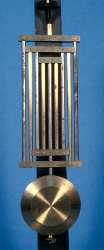
|
In 1725 the Englishman John Harrison invented
the gridiron pendulum, another solution to the temperature compensation
problem. Brass and iron rods, with different temperature coefficients
of expansion, were fastened alternately top and bottom in a gridiron pattern
to keep the center of mass at the same point.
The gridiron pendulum at the left is at Amherst College,
and is post-1875.
|
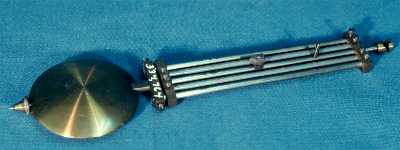
|
| This example is in the collection of the Smithsonian Institution. |
|
At the right is a model of a compensated pendulum
in the Garland Collection of Classical Physics Apparatus at Vanderbilt
University. It was probably purchased about 1875, and was purchased from
Deleuil of Paris. In the 1865 Deleuil catalogue the cost was 30 francs.
The overall length was
35 cm. |

|
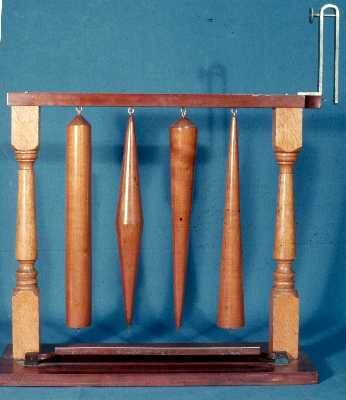
|
This multiple pendulum set at the Smithsonian is
from Colgate University in Hamilton, New York. When I discovered it in
the nineteen seventies, I was intrigued by the fact that the moment of
inertia and the location of the center of mass could be obtained by an
integration. With this information, the period of each physical pendulum
could be calculated. One of my students built a replica, and two decades
of Kenyon students have done the integrations and measured the periods of
each geometrical shape.
REF: Thomas B. Greenslade, Jr., "Reconstructed Nineteenth Century
Experiment with Physical Pendula". American Journal of Physics, 48, 487-8
(1980)
|
Of course, the pendulum is not truly isochronous. To a first
approximation, the increase in the period is proportional to the square
of the amplitude. This is a nasty calculation, and undergraduate students
have to be led carefully through the derivation.
About 1665 the Dutch physicist, Christiaan Huygens (1629-1695),
showed that a pendulum hung from a flexible support would have a period
independent of amplitude if the system were allowed to swing up against
guides in the shape of a cycloid.
As far as I know, no modern apparatus manufacturer has a cycloidal
pendulum in the catalogue. In the nineteenth century the situation was different.
At the left below is a cycloidal pendulum in the Smithsonian collection.
On the right is a cycloidal pendulum from Amherst College. It was made by
E. Ducretet & Cie of Paris, and cost 50 francs in the 1879 catalogue.
This is very close to the time when this apparatus was purchased by Amherst
to replace that lost in the fire that destroyed the original apparatus in
the early eighteen eighties.
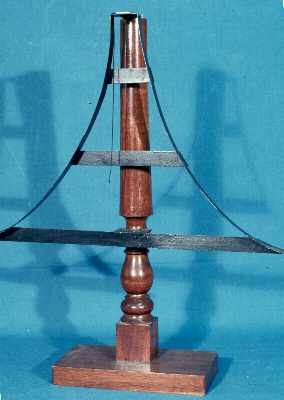
|
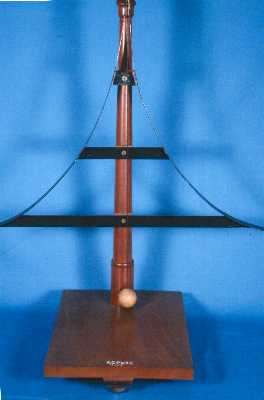
|
| This cycloidal pendulum stand was made in 1836 by
John Millington (1779-1868) when he was teaching at William and Mary College
in Williamsburg, Virginia.
Millington, who was born in England and spent fifteen
years as a lecturer at the Royal Institution, was the first Professor of
Natural Sciences at the new University of Mississippi from 1848 to 1853.
He brought a large collection of apparatus of his own manufacture with him
to Mississippi, and it forms the basis for the collection of apparatus in
the University Museum in Oxford. Other apparatus was ordered, mainly from
France, by his successor, Frederick Barnard (1809-1889) who was the president
of Columbia University after the War Between the States.
|
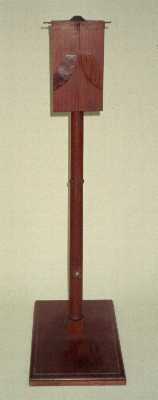
|
The device below is a modern example of Kater's Pendulum. This was
designed by Captain Henry Kater in 1818 for measurements of the strength
of the earth's gravitational field. The 1929 Central Scientific Company catalogue
describes it : "The bar is made of steel about 160 by 2.5 by 1 cm, white
nickel-plated [the plating has largely disappeared from this example], and
the knife edges are at a fixed distance and fitted with adjustments for
making them parallel. The weights of lacquered brass are adjustable along
the bar, the small weights being provided with a slow motion screw. ...
The ends of the pendulum are provided with detachable platinum points for
mercury contacts ... $60.00" The pendulum in the picture is in the Greenslade
Collection, and the weights have a non-rusting nickel finish.

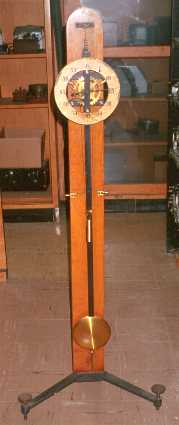
|
The Max Kohl catalogues of the second half of the 1920s had
clock pendulumns of increasing degrees of sophistication. The basic device
was the "seconds pendulum with audible beat, with dial and projecting pointer,
on iron stand with levelling screws". A little more money got you a mercury
contact at the bottom of the pendulum that provided an electrical signal every
time the pendulum passed through dead center. The next step up was a compensating
pendulum with five brass and four steel rods. All of the pendula had an effective
length of about one meter, giving a two-second period.
This example is in the physics department of Hobart and William
Smith Colleges in Geneva, New York.
At one time the Kenyon College physics department had a master
clock with a pendulum that sent out electrical time signals to many
of the rooms used by physics.
|
The 1928 catalogue of Max Kohl of Chemnitz, Germany identifies
this apparatus as Overbeck's Cross Pendulum. It cost 23 DM.
The positions of the sliders can be adjusted to give various
moments of inertia and centers of mass for experiments with the period of
the pendulum.
|
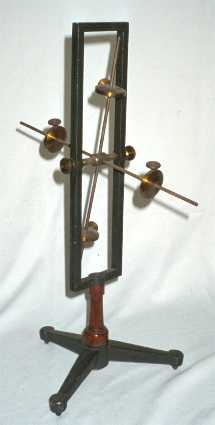
|
Return to Mechanics
Home Page | Return to Home Page